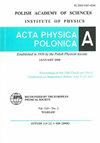Electron Localization in Rydberg States
IF 0.5
4区 物理与天体物理
Q4 PHYSICS, MULTIDISCIPLINARY
引用次数: 0
Abstract
We discuss the possibility of localizing an electron in a highly excited Rydberg state. The second-order correlation of emitted photons is the tool for the determination of electron position. This second-order correlation of emitted radiation and, therefore, the correlation of operators describing the acceleration of the electron allows for a partial localization of the electron in its orbit. The correlation function is found by approximating the transition matrix elements by their values in the classical limit. It is shown that the second-order correlation, depending on two times, is a function of the time difference and is a periodic function of this argument with the period equal to the period of the corresponding classical motion. The function has sharp maxima corresponding to large electron acceleration in the vicinity of the ``perihelion.'' This allows the localization of the electron in its consecutive approach to the perihelion point.里德堡态的电子局域化
我们讨论了在高激发态定位电子的可能性。发射光子的二阶相关是确定电子位置的工具。发射的辐射的二阶相关,因此,描述电子加速度的算子的相关,允许电子在其轨道上的部分定位。用过渡矩阵元素在经典极限下的值逼近过渡矩阵元素,求出相关函数。结果表明,二阶相关,取决于两次,是时间差的函数,并且是该参数的周期函数,其周期等于相应经典运动的周期。该函数在近日点附近有明显的极大值,对应于较大的电子加速度。“这允许电子在其连续接近近日点时定位。
本文章由计算机程序翻译,如有差异,请以英文原文为准。
求助全文
约1分钟内获得全文
求助全文
来源期刊

Acta Physica Polonica A
物理-物理:综合
CiteScore
1.50
自引率
0.00%
发文量
141
审稿时长
6 months
期刊介绍:
Contributions which report original research results
and reviews in the fields of General Physics, Atomic and
Molecular Physics, Optics and Quantum Optics, Quantum Information, Biophysics, Condensed Matter, and
Applied Physics are welcomed.
 求助内容:
求助内容: 应助结果提醒方式:
应助结果提醒方式:


